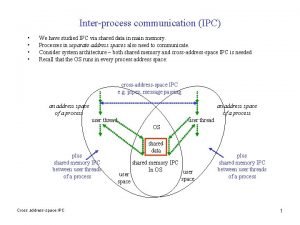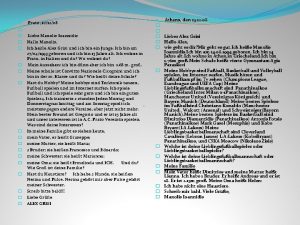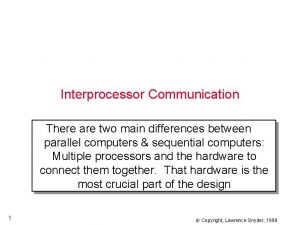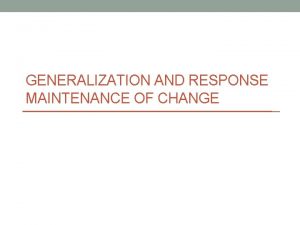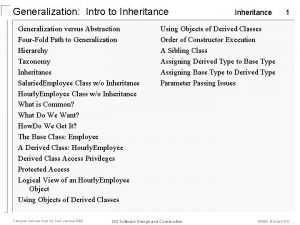Interprocessor Communication seen as loadstore instruction generalization Manolis












- Slides: 12

Interprocessor Communication seen as load/store instruction generalization Manolis Katevenis FORTH and University of Crete, Greece Interprocessor Communication - M. Katevenis

Summary • Central importance of Interprocessor Communication • Must go from low-speed I/O to high-speed p 2 p commun. • Data Transfer Primitives: Remote DMA, Remote Queues • Cache operations on top of Network Interface primitives? • Combined Translation/Routing Tables – Data Migration Interprocessor Communication - M. Katevenis 2

Communication Primitives: Intra-Node, Inter-Node • Processor to Memory communication: – Load/Store primitives Interprocessor Communication - M. Katevenis • Interprocessor communication: – Read/Write (send/receive) data transfer primitives 3

Remote DMA as generalization of single-word Instr’ns • block size is chosen so as to reduce overheads relative to data payload Interprocessor Communication - M. Katevenis 4

Remote DMA is for One-to-One Communication • Independent (unsynchronized) transfers have to occur into distinct memory regions • Expensive when many potential senders but few actual ones – buffer reservation cost, polling-for-completion overhead Interprocessor Communication - M. Katevenis 5

Multi-Party Synchronization: Remote Queues • • Atomic enqueue into shared space, unlike dedicated sp. with RDMA Space reserved only for # of actual senders – not potential senders Speeds up polling / waiting on multiple receive channels Appropriate for synchronization (remote enqueue) & job dispatching (remote dequeue) – generalization of atomic operations Interprocessor Communication - M. Katevenis 6

Cache Operations related to RDMA • • Network interface as close to the processor as (L 1) cache Messages or RDMA commands composed via store instr’ns Cache line eviction is a case of Remote Write DMA Is there potential for the cache controller to use the primitives supplied by the network interface? Interprocessor Communication - M. Katevenis 7

Cache Read Misses are like Remote Read DMA’s • Network Interface as close to the processor as (L 1) cache • Should the NI be combined with the cache controller? • Should portions of cache coherence protocols be left to the software, with NI hardware assistance for the rest? Interprocessor Communication - M. Katevenis 8

Network Routing as Generalization of Address Decoding • (a) Physical address decoding in a uniprocessor • (b) geographical address routing in a multiprocessor Interprocessor Communication - M. Katevenis 9

Address Translation for Transparent Data Migration • Two methods to support data migration: (a) Translation table: first consult an indirection/routing table/directory (b) Cache style: search multiple places in parallel Interprocessor Communication - M. Katevenis 10

Progressive Translation: Localize Migration Updates • Packets carry global virtual addresses • Tables provide physical route (address) for the next few steps • When page 9 migrates within D, only tables in that domain need updating • Variable-size-page translation tables look like internet routing tables (longest-prefix matches if we want small-page-within-big-region migration) • Tables that partition the system, for protection against untrusted operating systems, look like internet firewalls Interprocessor Communication - M. Katevenis 11

Conclusions • Hardware should provide “Primitives” – not “solutions” – few, simple, general-purpose, flexibly combinable primitives • Data transport primitive: Remote DMA • Synchronization primitive: Remote Enqueue • Cache operation on top of Network Interface primitives? • Translation/Routing Tables for Data Migration support Interprocessor Communication - M. Katevenis 12
 Interprocessor communication takes place via
Interprocessor communication takes place via Multiprocessor and its characteristics
Multiprocessor and its characteristics Parallel arbitration logic
Parallel arbitration logic Differentiated instruction vs individualized instruction
Differentiated instruction vs individualized instruction Direct instruction strategies
Direct instruction strategies Valid generalization
Valid generalization How to generalize a paragraph
How to generalize a paragraph Acquisition fluency maintenance generalization
Acquisition fluency maintenance generalization Generalization in database
Generalization in database Skinner watson pavlov
Skinner watson pavlov Logical fallacies in animal farm
Logical fallacies in animal farm Transfer persuasive technique
Transfer persuasive technique Analytic phonics
Analytic phonics
